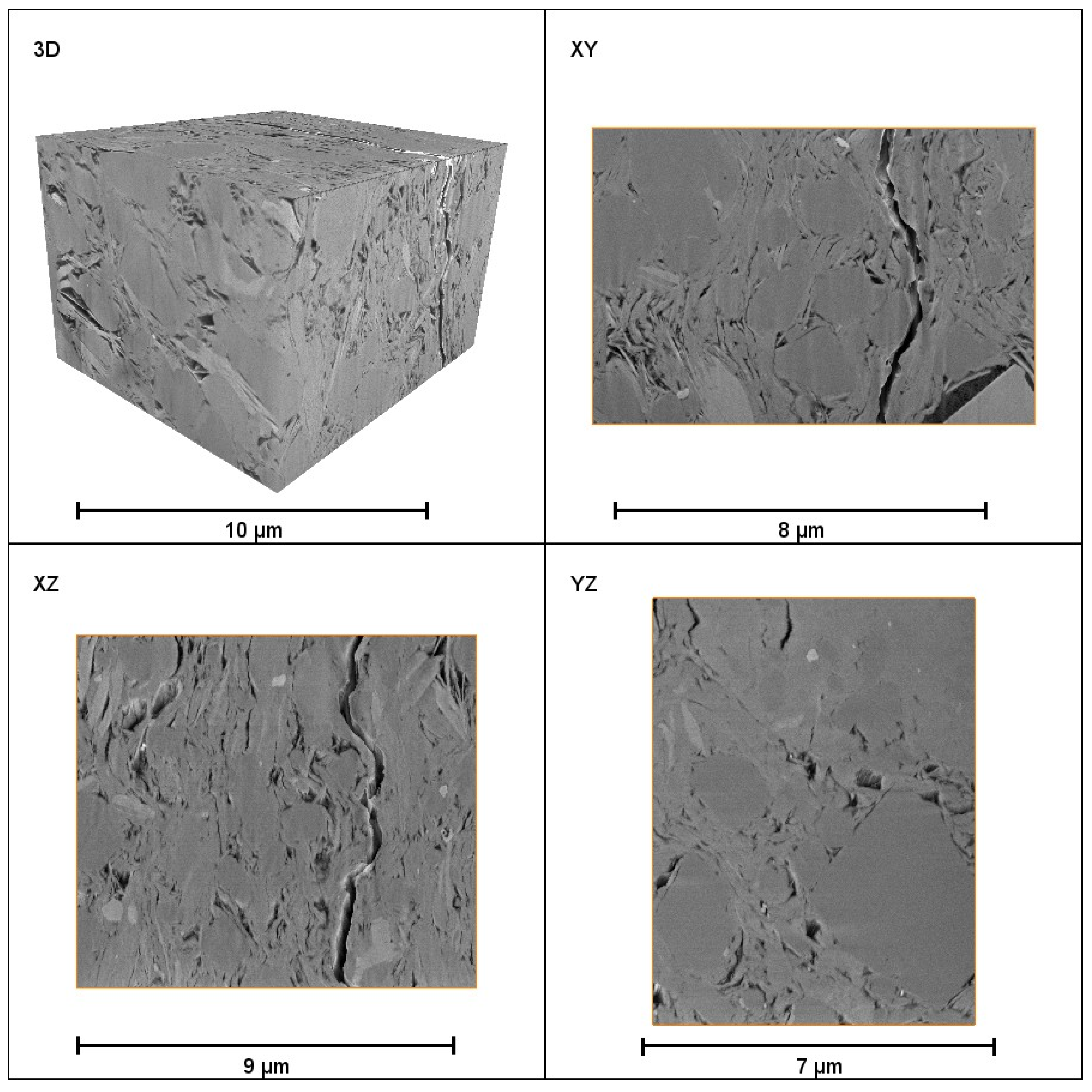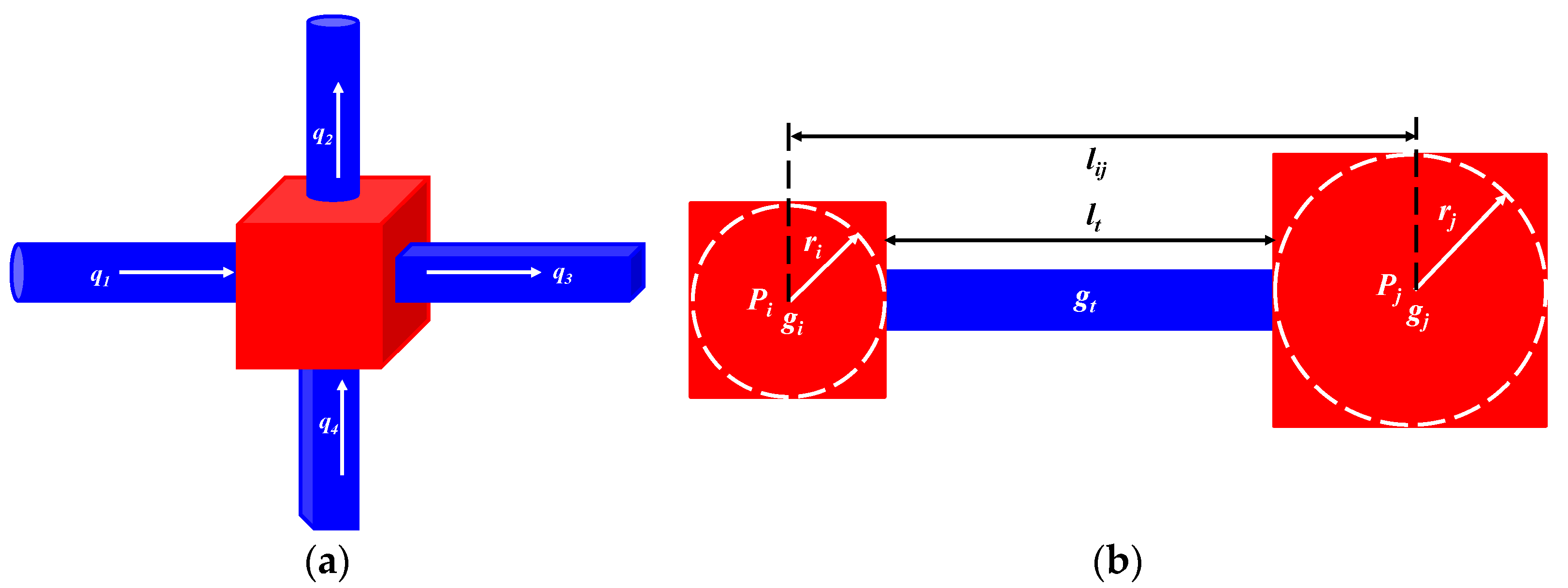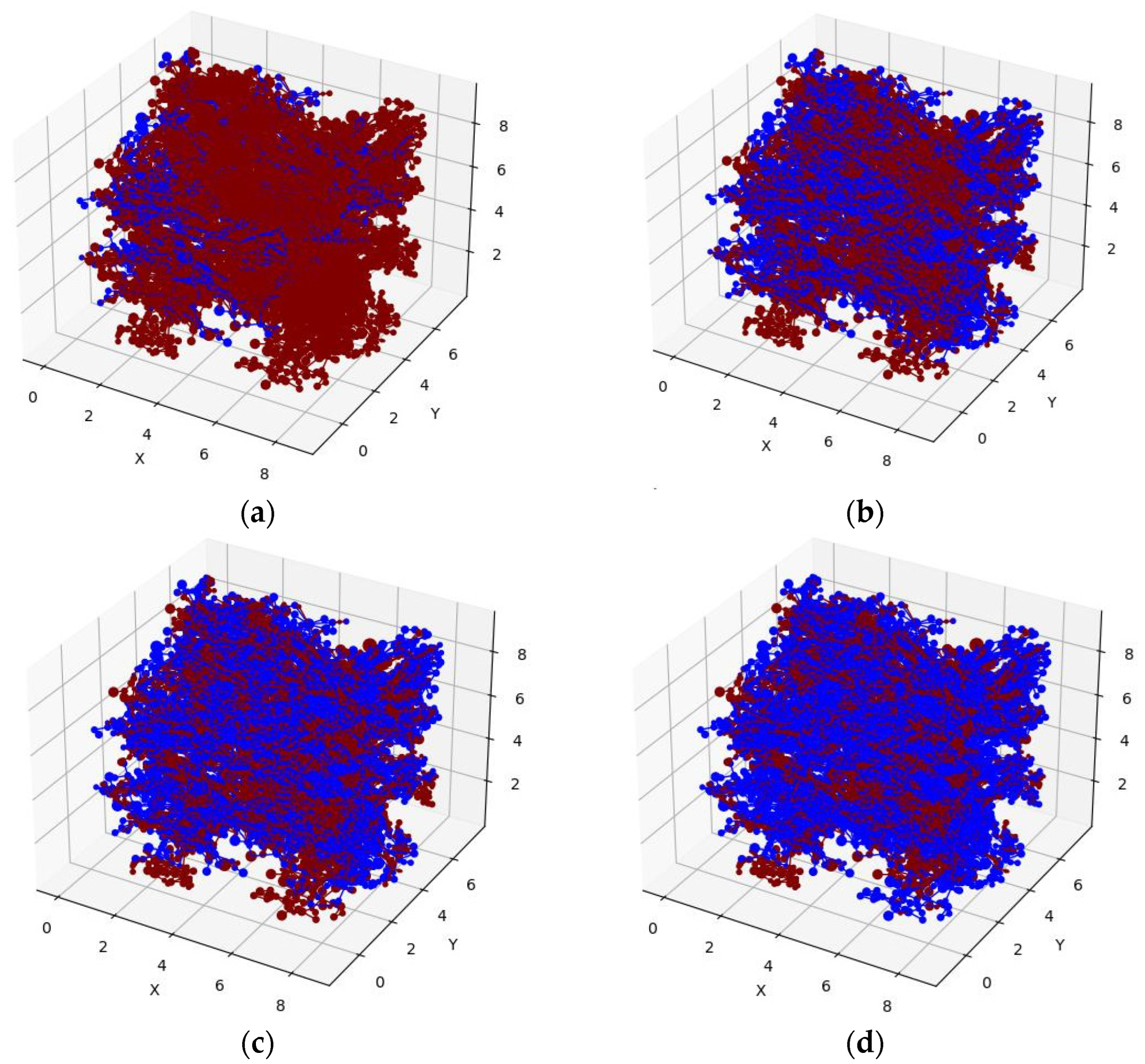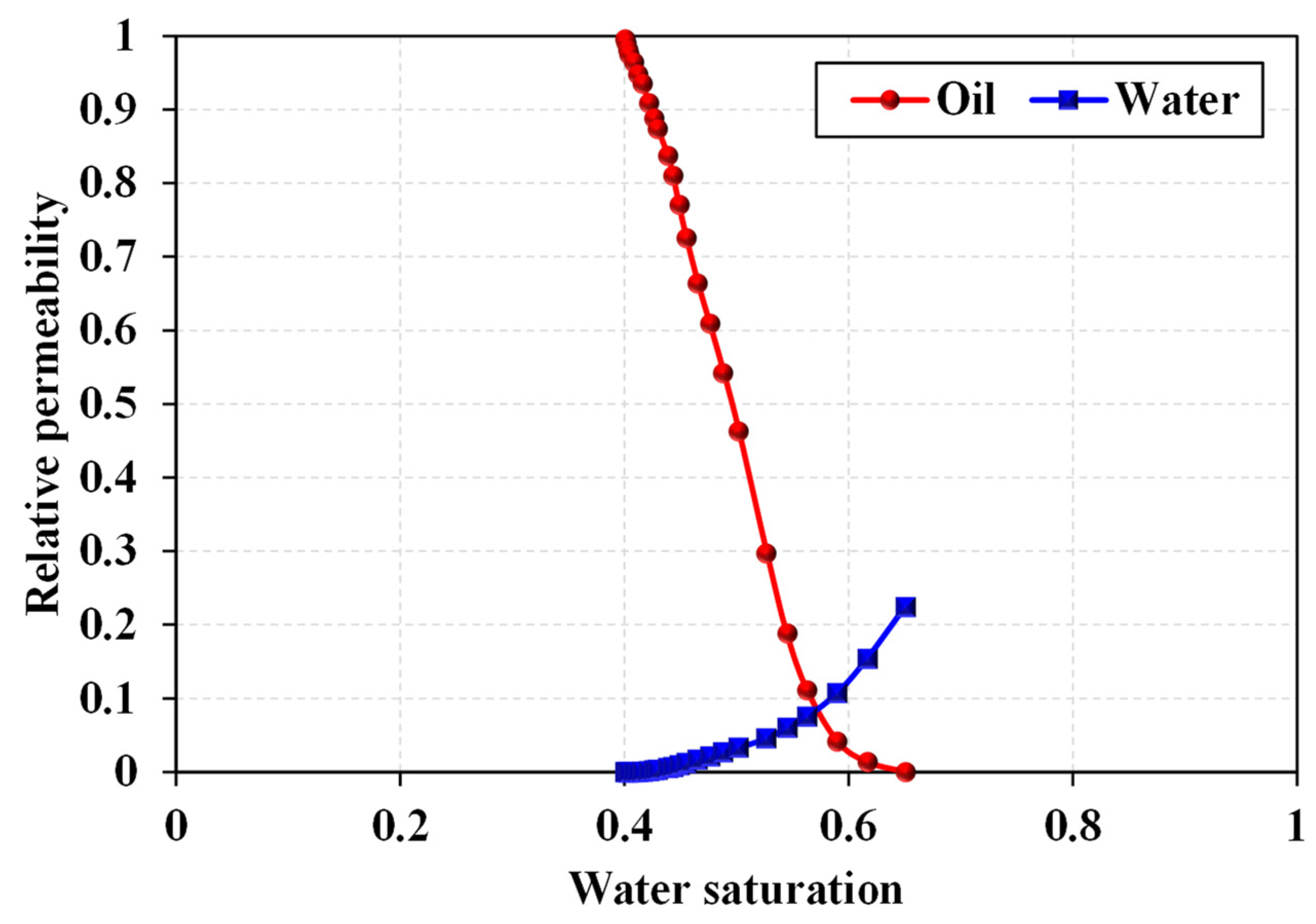Characterization of Flow Parameters in Shale Nano-Porous Media Using Pore Network Model: A Field Example from Shale Oil Reservoir in Songliao Basin, China
Abstract
:1. Introduction
2. Methodology
2.1. Establishment of Pore Network Model Based on FIB-SEM
2.2. Quasi-Static Single-Phase Flow Equations Considering Diffusion
2.3. Quasi-Static Two-Phase Flow Equations
3. Model Validation
4. Results and Discussion
4.1. Pore-Throat Parameter Characterization
4.2. Apparent Permeability Characterization
4.3. Relative Permeability Curves Characterization
5. Conclusions
Author Contributions
Funding
Data Availability Statement
Conflicts of Interest
Nomenclature
| A | Cross-sectional area of the network model, m2 |
| DK | Knudsen diffusion coefficient, m2/s |
| DF | Fick diffusion coefficient, m2/s |
| DT | Transition diffusion coefficient, m2/s |
| d | Equivalent pore-throat diameter, m |
| gij | Conductivity |
| gp,ij | Effective conductivity of p phase |
| Kn | Knudsen number |
| kB | Boltzmann constant, 1.3806488 × 10−23 J/K |
| kabs | Absolute permeability, mD |
| kp | Effective permeability of p phase, mD |
| krp | Relative permeability of p phase |
| L | Length of pore network model, m |
| Lij | Distance between pore i and adjacent pore j |
| Ni | The number of pores connected to pore i |
| ∆p | The differential pressure at both ends of the network model, Pa |
| pi, pj | Pore pressure of numbered i, j |
| Pp,i, Pp,j | The pore i and p phase fluid pressure in j |
| Q | The outlet or inlet flow of the network model, m3/s |
| q | Flow into or out of the pore |
| M | Molecular molar mass, g/mol |
| R | Ideal gas constant, 8.314462 J/(mol·K) |
| Sw | Water saturation of the pore network model |
| V | Volume of pore network model, m3 |
| λ | Mean free path, m |
| δ | Collision diameter of molecule, m |
References
- Dou, W.; Liu, L.; Jia, L. Pore structure, fractal characteristics and permeability prediction of tight sandstones: A case study from Yanchang Formation, Ordos Basin, China. Mar. Pet. Geol. 2021, 123, 104737. [Google Scholar] [CrossRef]
- Jia, Z.; Cheng, L.; Feng, H. Full composition numerical simulation of CO2 utilization process in shale reservoir using projection-based embedded discrete fracture model (pEDFM) considering nano-confinement effect. Gas Sci. Eng. 2023, 111, 204932. [Google Scholar] [CrossRef]
- Noiriel, C.; Seigneur, N.; Le Guern, P. Geometry and mineral heterogeneity controls on precipitation in fractures: An X-ray micro-tomography and reactive transport modeling study. Adv. Water Resour. 2021, 152, 103916. [Google Scholar] [CrossRef]
- Lai, J.; Wang, G.; Wang, Z. A review on pore structure characterization in tight sandstones. Earth-Sci. Rev. 2018, 177, 436–457. [Google Scholar] [CrossRef]
- Hasnan, H.K.; Sheppard, A.; Hassan, M.H. Digital core analysis: Characterizing reservoir quality through thin sandstone layers in heterolithic rocks. J. Appl. Geophys. 2020, 182, 104178. [Google Scholar] [CrossRef]
- Hasnan, H.K.; Sheppard, A.; Hassan, M.H. Digital core analysis: Improved connectivity and permeability characterization of thin sandstone layers in heterolithic rocks. Mar. Pet. Geol. 2020, 120, 104549. [Google Scholar] [CrossRef]
- Lv, W.; Chen, S.; Gao, Y. Evaluating seepage radius of tight oil reservoir using digital core modeling approach. J. Pet. Sci. Eng. 2019, 178, 609–615. [Google Scholar] [CrossRef]
- Ettemeyer, F.; Lechner, P.; Hofmann, T. Digital sand core physics: Predicting physical properties of sand cores by simulations on digital microstructures. Int. J. Solids Struct. 2020, 188–189, 155–168. [Google Scholar] [CrossRef]
- Venkatarangan, W. Investigating 3D geometry of porous media from high resolution images. Phys. Chem. Earth Part A Solid Earth Geod. 1999, 24, 593–599. [Google Scholar] [CrossRef]
- Tan, M.; Su, M.; Liu, W. Digital core construction of fractured carbonate rocks and pore-scale analysis of acoustic properties. J. Pet. Sci. Eng. 2021, 196, 107771. [Google Scholar] [CrossRef]
- Xiong, Q.; Baychev, T.G.; Jivkov, A.P. Review of pore network modelling of porous media: Experimental characterisations, network constructions and applications to reactive transport. J. Contam. Hydrol. 2016, 192, 101–117. [Google Scholar] [CrossRef]
- Xu, Z.; Lin, M.; Jiang, W. Rapid multiscale pore network modeling for drainage in tight sandstone. J. Pet. Sci. Eng. 2021, 204, 108682. [Google Scholar] [CrossRef]
- Yi, Z.; Hu, S.; Wu, S. Pore network extraction for shale gas flow in nanoporous media. Mar. Pet. Geol. 2021, 126, 104896. [Google Scholar] [CrossRef]
- Meng, Z.; Sun, W.; Liu, Y. Effect of pore networks on the properties of movable fluids in tight sandstones from the perspective of multi-techniques. J. Pet. Sci. Eng. 2021, 201, 108449. [Google Scholar] [CrossRef]
- El-Zehairy, A.A.; Nezhad, M.M.; Joekar-Niasar, V. Pore-network modelling of non-Darcy flow through heterogeneous porous media. Adv. Water Resour. 2019, 131, 103378. [Google Scholar] [CrossRef]
- Ahmad, F.; Talbi, M.; Prat, M. Non-local equilibrium continuum modeling of partially saturated drying porous media: Comparison with pore network simulations. Chem. Eng. Sci. 2020, 228, 115957. [Google Scholar] [CrossRef]
- Rodríguez de Castro, A.; Goyeau, B. A pore network modelling approach to investigate the interplay between local and Darcy viscosities during the flow of shear-thinning fluids in porous media. J. Colloid Interface Sci. 2021, 590, 446–457. [Google Scholar] [CrossRef] [PubMed]
- Yin, X.; Zhang, J. An improved bounce-back scheme for complex boundary conditions in lattice Boltzmann method. J. Comput. Phys. 2012, 231, 4295–4303. [Google Scholar] [CrossRef]
- Matsuyama, T.; Abe, T.; Yamamoto, H. Lattice Boltzmann method study of Rayleigh instability of a charged droplet. Adv. Powder Technol. 2007, 18, 93–104. [Google Scholar] [CrossRef]
- Pribec, I.; Hubman, A.; Urbic, T. A discrete reactive collision scheme for the lattice Boltzmann method. J. Mol. Liq. 2021, 332, 115871. [Google Scholar] [CrossRef]
- Wilde, D.; Krämer, A.; Bedrunka, M. Cubature rules for weakly and fully compressible off-lattice Boltzmann methods. J. Comput. Sci. 2021, 51, 101355. [Google Scholar] [CrossRef]
- Shams, M.; Raeini, A.Q.; Blunt, M.J. A numerical model of two-phase flow at the micro-scale using the volume-of-fluid method. J. Comput. Phys. 2018, 357, 159–182. [Google Scholar] [CrossRef]
- Carrillo, F.J.; Bourg, I.C.; Soulaine, C. Multiphase flow modeling in multiscale porous media: An open-source micro-continuum approach. J. Comput. Phys. X 2020, 8, 100073. [Google Scholar] [CrossRef]
- Sengupta, A.; Adhikari, J. Fluid phase equilibria of triangle-well fluids confined inside slit pores: A transition matrix Monte Carlo simulation study. J. Mol. Liq. 2016, 221, 1184–1196. [Google Scholar] [CrossRef]
- Karki, S.; Chakraborty, S.N. A Monte Carlo simulation study of hydrogen adsorption in slit-shaped pores. Microporous Mesoporous Mater. 2021, 317, 110970. [Google Scholar] [CrossRef]
- Ryazanov, A.V.; Dijke, M.I.; Sorbie, K.S. Two-Phase Pore-Network Modelling: Existence of Oil Layers During Water Invasion. Transp. Porous Media 2009, 80, 79–99. [Google Scholar] [CrossRef]
- Høiland, L.K.; Spildo, K.; Skauge, A. Fluid flow properties for different classes of intermediate wettability as studied by network modelling. Transp. Porous Media 2007, 70, 127–146. [Google Scholar] [CrossRef]
- Piri, M.; Blunt, M.J. Three-dimensional mixed-wet random pore-scale network modeling of two- and three-phase flow in porous media. I. Model description. Phys. Rev. E Stat. Nonlin. Soft Matter Phys. 2005, 71, 026301. [Google Scholar] [CrossRef]
- Piri, M.; Blunt, M.J. Three-dimensional mixed-wet random pore-scale network modeling of two- and three-phase flow in porous media. II. Results. Phys. Rev. E Stat. Nonlin. Soft Matter Phys. 2005, 71, 026302. [Google Scholar] [CrossRef] [Green Version]
- Valvatne, P.H.; Blunt, M.J. Predictive pore-scale modeling of two-phase flow in mixed wet media. Water Resour. Res. 2004, 40, W07406. [Google Scholar] [CrossRef] [Green Version]
- Bakke, S.; Øren, P.E. 3-D Pore-Scale Modelling of Sandstones and Flow Simulations in the Pore Networks. SPE J. 1997, 2, 136–149. [Google Scholar] [CrossRef] [Green Version]
- Bryant, S.; Blunt, M. Prediction of relative permeability in simple porous media. Phys. Rev. A 1992, 46, 2004–2011. [Google Scholar] [CrossRef] [PubMed]
- Ryazanov, A.; Dijke, M.V.; Sorbie, K. Pore-network Prediction of Residual Oil Saturation Based on Oil Layer Drainage in Mixed-wet Systems. In Proceedings of the SPE Improved Oil Recovery Symposium, Tulsa, OK, USA, 24–28 April 2010. [Google Scholar] [CrossRef]
- Joekar-Niasar, V.; Prodanović, M.; Wildenschild, D. Network model investigation of interfacial area, capillary pressure and saturation relationships in granular porous media. Water Resour. Res. 2010, 46, W06526. [Google Scholar] [CrossRef] [Green Version]
- Jones, F.O.; Owens, W.W. A Laboratory Study of Low-Permeability Gas Sands. J. Pet. Technol. 1980, 32, 1631–1640. [Google Scholar] [CrossRef]
- Tian, X.; Cheng, L.; Cao, R. A new approach to calculate permeability stress sensitivity in tight sandstone oil reservoirs considering micro-pore-throat structure. J. Pet. Sci. Eng. 2015, 133, 576–588. [Google Scholar] [CrossRef]
- Valvatne, P.H.; Piri, M.; Lopez, X. Predictive Pore-Scale Modeling of Single and Multiphase Flow. Transp. Porous Media 2005, 58, 23–41. [Google Scholar] [CrossRef]
- Zheng, D.; Reza, Z. Prediction of pore-scale transport properties in unconventional reservoirs using novel theoretical dendroidal pore-network model. J. Pet. Sci. Eng. 2018, 170, 712–720. [Google Scholar] [CrossRef]
- Tian, X.; Daigle, H. Permeability prediction from a pore-scale network model constrained by low-pressure nitrogen sorption isotherms. J. Pet. Sci. Eng. 2018, 162, 554–566. [Google Scholar] [CrossRef]
- Azarafza, A.; King, A.J.; Mead-Hunter, R. Prediction of residual saturation and pressure drop during coalescence filtration using dynamic pore network model. Sep. Purif. Technol. 2021, 254, 117588. [Google Scholar] [CrossRef]
- Merey, Ş. Prediction of transport properties for the Eastern Mediterranean Sea shallow sediments by pore network modelling. J. Pet. Sci. Eng. 2019, 176, 403–420. [Google Scholar] [CrossRef]
- Dakhelpour-Ghoveifel, J.; Shahverdi, H. Prediction of gas-oil capillary pressure of carbonate rock using pore network modeling. J. Pet. Sci. Eng. 2020, 195, 107861. [Google Scholar] [CrossRef]
- Dias, M.M.; Wilkinson, D. Percolation with trapping. J. Phys. A Math. Gen. 1986, 19, 3131–3146. [Google Scholar] [CrossRef]
- Knackstedt, M.A.; Sahimi, M.; Sheppard, A.P. Invasion percolation with long-range correlations: First-order phase transition and nonuniversal scaling properties. Phys. Rev. E 2000, 61, 4920–4934. [Google Scholar] [CrossRef] [PubMed] [Green Version]
- Wilkinson, D.; Willemsen, J.F. Invasion percolation: A new form of percolation theory. J. Phys. A Math. Gen. 1983, 16, 3365–3376. [Google Scholar] [CrossRef]
- Broadbent, S.R.; Hammersley, J.M. Percolation processes: I. Crystals and mazes. Math. Proc. Camb. Philos. Soc. 1957, 53, 629–641. [Google Scholar] [CrossRef]
- Dullien, F.A.L. New network permeability model of porous media. Aiche J. 1975, 21, 299–307. [Google Scholar] [CrossRef]
- Lenormand, R.; Zarcone, C.; Sarr, A. Mechanisms of the displacement of one fluid by another in a network of capillary ducts. J. Fluid Mech. 1983, 135, 337–353. [Google Scholar] [CrossRef] [Green Version]
- Oak, M.J.; Baker, L.E.; Thomas, D.C. Three-Phase Relative Permeability of Berea Sandstone. J. Pet. Technol. 1990, 42, 1054–1061. [Google Scholar] [CrossRef]
- Øren, P.E.; Pinczewski, W.V. Fluid distribution and pore-scale displacement mechanisms in drainage dominated three-phase flow. Transp. Porous Media 1995, 20, 105–133. [Google Scholar] [CrossRef]
- Blunt, M.J. Effects of Heterogeneity and Wetting on Relative Permeability Using Pore Level Modeling. SPE J. 1997, 2, 70–87. [Google Scholar] [CrossRef]
- Blunt, M.J. Physically-based network modeling of multiphase flow in intermediate-wet porous media. J. Pet. Sci. Eng. 1998, 20, 117–125. [Google Scholar] [CrossRef]
- Øren, P.; Bakke, S.; Arntzen, O.J. Extending Predictive Capabilities to Network Models. SPE J. 1998, 3, 326–336. [Google Scholar] [CrossRef]
- VOGEL, J.H. Morphological determination of pore connectivity as a function of pore size using serial sections. Eur. J. Soil Sci. 2008, 48, 365–377. [Google Scholar] [CrossRef]
- Vogel, H.J. A numerical experiment on pore size, pore connectivity, water retention, permeability, and solute transport using network models. Eur. J. Soil Sci. 2000, 51, 99–105. [Google Scholar] [CrossRef]
- Blunt, M.J.; Jackson, M.D.; Piri, M. Detailed physics, predictive capabilities and macroscopic consequences for pore-network models of multiphase flow. Adv. Water Resour. 2002, 25, 1069–1089. [Google Scholar] [CrossRef]
- Chen, M.; Cheng, L.; Wang, X. Pore network modelling of fluid flow in tight formations considering boundary layer effect and media deformation. J. Pet. Sci. Eng. 2019, 180, 643–659. [Google Scholar] [CrossRef]
- Jia, Z.; Cheng, L.; Zhou, J. Upscaling simulation method of fluid flow for fracturing-shut in-flowback-production process in tight oil reservoirs: Hysteresis effects of capillary pressure and relative permeability. Geoenergy Sci. Eng. 2023, 226, 211792. [Google Scholar] [CrossRef]
- Cai, J.; Lin, D.; Singh, H.; Zhou, S.; Meng, Q.; Zhang, Q. A simple permeability model for shale gas and key insights on relative importance of various transport mechanisms. Fuel 2019, 252, 210–219. [Google Scholar] [CrossRef]
- Sun, L.; Cui, B.; Zhu, R.; Wang, R.; Feng, Z.; Li, B.; Zhang, J.; Gao, B.; Wang, Q.; Zeng, H.; et al. Shale oil enrichment evaluation and production law in Gulong Sag, Songliao Basin, NE China. Pet. Explor. Dev. 2023, 50, 505–519. [Google Scholar] [CrossRef]









| Parameter Types | Simulation Parameter | Unit | Value |
|---|---|---|---|
| Basic pore-throat Parameters | Pore number | / | 8717 |
| Throat number | / | 18,494 | |
| Initial temperature | °C | 137 | |
| Initial pressure | MPa | 37.5 | |
| Single-phase flow parameters | Gas viscosity | mPa·s | 0.02 |
| Collision diameter | m | 3 × 10−10 | |
| Molecular molar mass | g/mol | 28 | |
| Two-phase flow parameters | Oil density | g/cm3 | 0.7 |
| Water density | g/cm3 | 1 | |
| Oil viscosity | mPa·s | 0.5 | |
| Water viscosity | mPa·s | 1 | |
| Oil–water contact angle | ° | 60 | |
| Oil–water interfacial tension | mN/m | 20 |
| Parameters | Units | Physical Experiments | Experiments by Sun et al. [60] | Pore Network Model |
|---|---|---|---|---|
| Effective Porosity | % | 8.29 | 8.4~9.1 | 7.96 |
| Permeability | mD | 0.002 | 0.001~0.05 | 0.00124 |
Disclaimer/Publisher’s Note: The statements, opinions and data contained in all publications are solely those of the individual author(s) and contributor(s) and not of MDPI and/or the editor(s). MDPI and/or the editor(s) disclaim responsibility for any injury to people or property resulting from any ideas, methods, instructions or products referred to in the content. |
© 2023 by the authors. Licensee MDPI, Basel, Switzerland. This article is an open access article distributed under the terms and conditions of the Creative Commons Attribution (CC BY) license (https://creativecommons.org/licenses/by/4.0/).
Share and Cite
Wang, Q.; Jia, Z.; Cheng, L.; Li, B.; Jia, P.; Lan, Y.; Dong, D.; Qu, F. Characterization of Flow Parameters in Shale Nano-Porous Media Using Pore Network Model: A Field Example from Shale Oil Reservoir in Songliao Basin, China. Energies 2023, 16, 5424. https://doi.org/10.3390/en16145424
Wang Q, Jia Z, Cheng L, Li B, Jia P, Lan Y, Dong D, Qu F. Characterization of Flow Parameters in Shale Nano-Porous Media Using Pore Network Model: A Field Example from Shale Oil Reservoir in Songliao Basin, China. Energies. 2023; 16(14):5424. https://doi.org/10.3390/en16145424
Chicago/Turabian StyleWang, Qingzhen, Zhihao Jia, Linsong Cheng, Binhui Li, Pin Jia, Yubo Lan, Dapeng Dong, and Fangchun Qu. 2023. "Characterization of Flow Parameters in Shale Nano-Porous Media Using Pore Network Model: A Field Example from Shale Oil Reservoir in Songliao Basin, China" Energies 16, no. 14: 5424. https://doi.org/10.3390/en16145424





